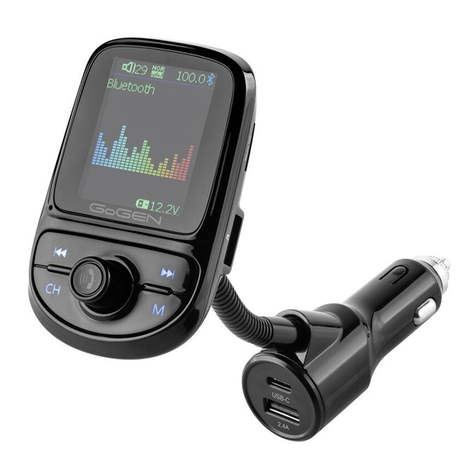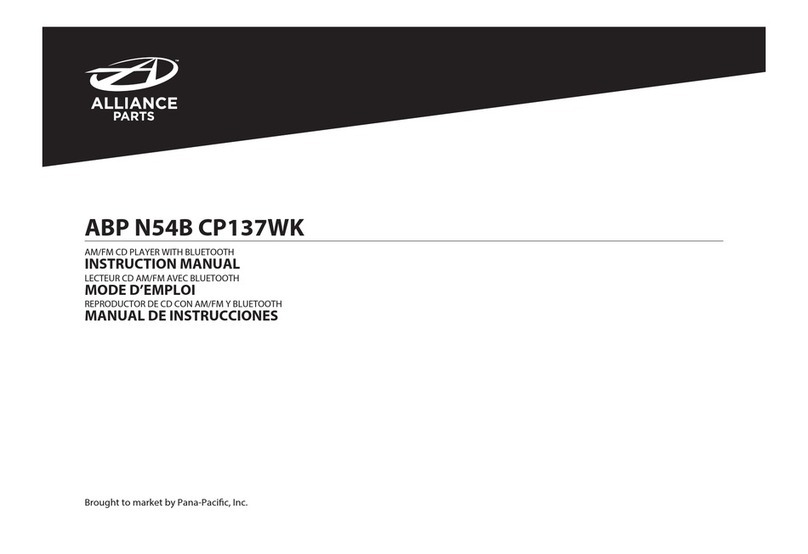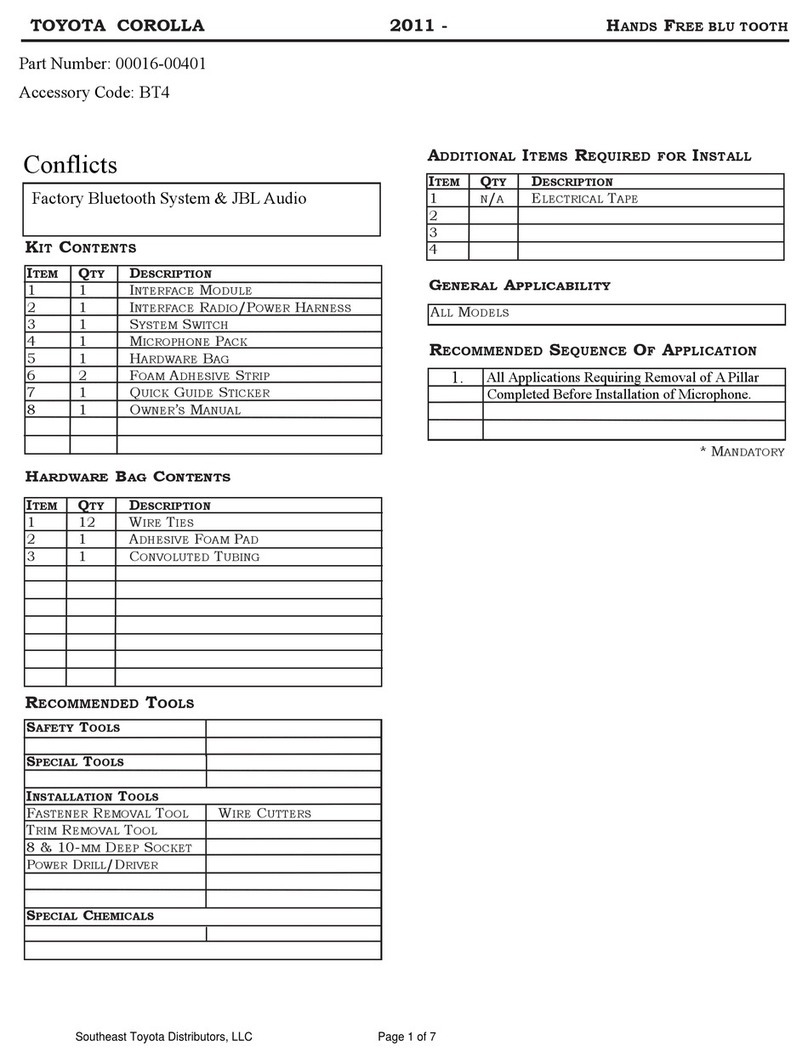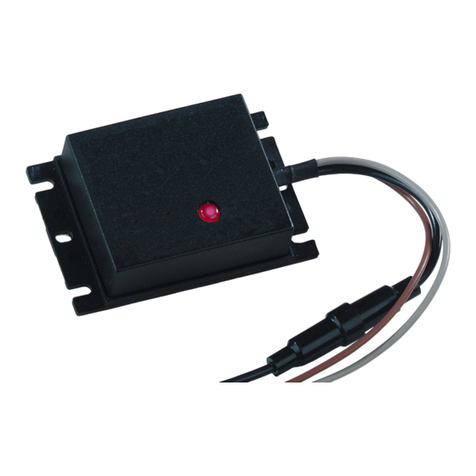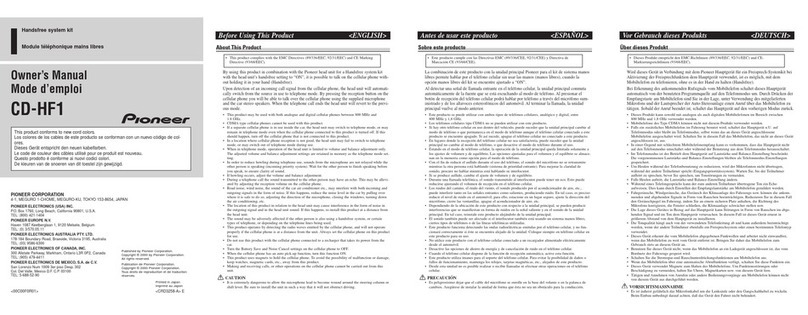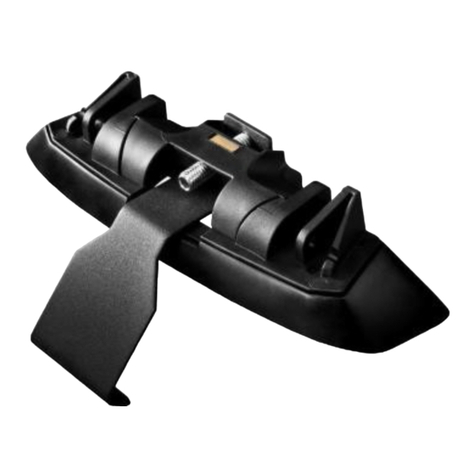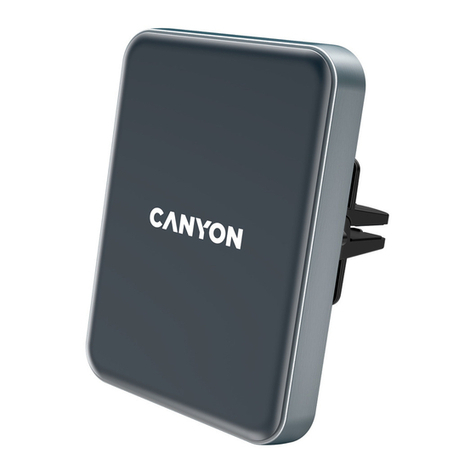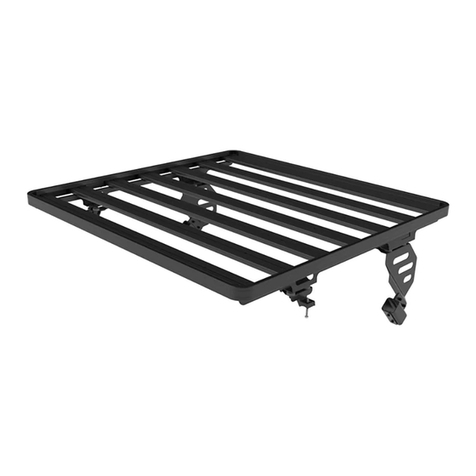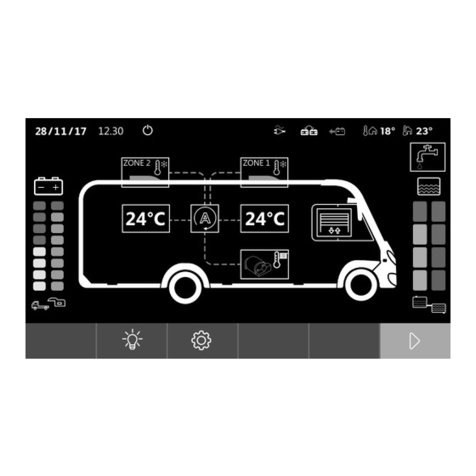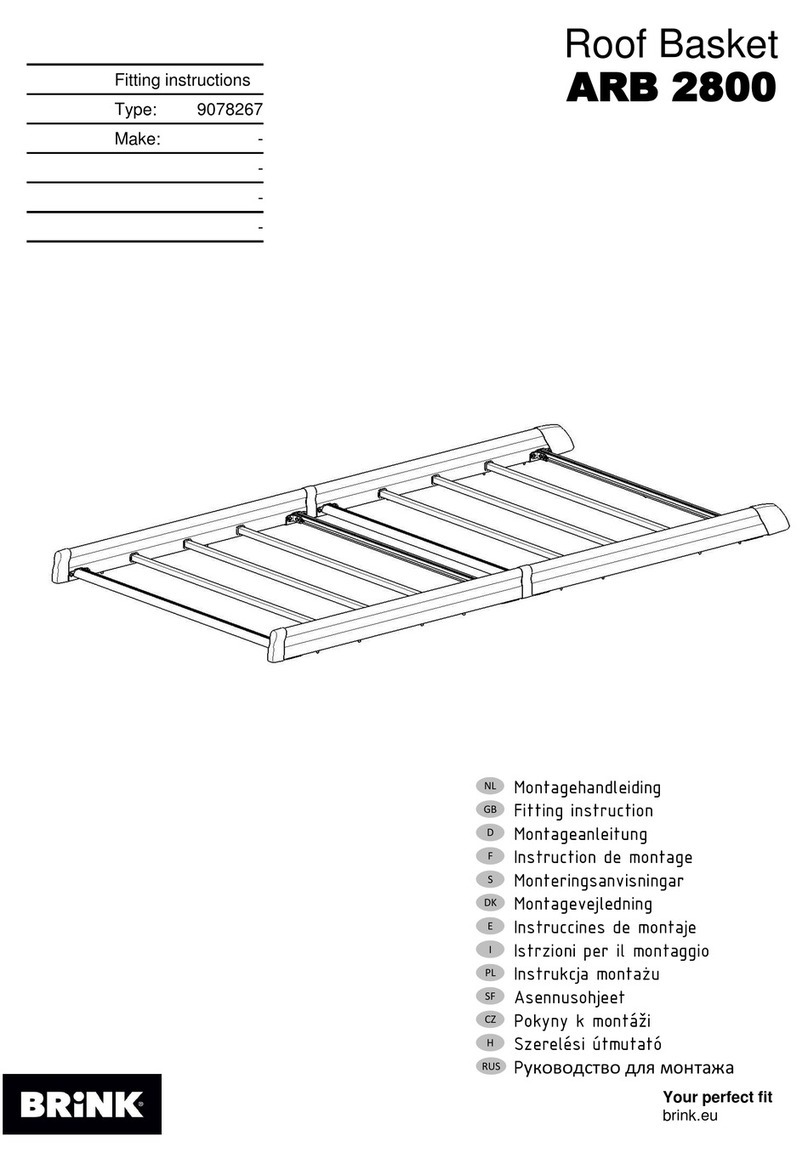Spotlight 645046 User manual

GB JOCKEY WHEEL 48 mm
ES RUEDA JOCKEY 48 mm
PT RODA JOCKEY 48 mm
NL NEUSWIEL 48 mm
Notice d’utilisation et d’entretien - Instruction manual - Instrucciones - Instruicoese - Handleiding
Réf. 645046
Roue jockey acier galvanisé
avec collier Ø 48 mm

FR
NOTE : Lire attentivement la notice d’utilisation et la comprendre avant d’utiliser le matériel.
CONSIGNES DE SECURITÉ
1/ La roue jockey n’est pas prévue pour supporter de lourdes charges et ne doit en aucun cas être utilisée lorsque votre remorque
est chargée.
2/ Attention, le chargement d’une remorque est un acte responsable, les conséquences d’un mauvais chargement peuvent être
très graves :
- Surcharge avant : risque de rupture du timon ou de la flèche
- Surcharge générale : risque d’éclatement des pneumatiques, de rupture de la flèche et de l’essieu, déformation des longerons et
du châssis, mauvais freinage, usure prématurée des roulements
- Surcharge arrière : risque de tangage et mise en portefeuille de la remorque
3/ Vérifier le bon serrage de la visserie avant chaque utilisation.
4/ Vérifier le fonctionnement de la roue jockey en faisant tourner entièrement la roue. Si besoin graisser la tige.
5/ Durant la conduite la roue jockey peut être arrachée et projetée. Lorsque la remorque est attelée au véhicule ou lorsqu’elle est
en charge, il est conseillé, pour des raisons de sécurité, de retirer la roue jockey de son support.
6/ Durant la conduite, une roue jockey mal positionnée peut bloquer le système de freinage de votre remorque. Avant de prendre
la route, il faut s’assurer que la timonerie de frein ne soit pas bloquée par la roue jockey. Pour cela il faut positionner la roue jockey
parallèlement à la timonerie de frein.
7/ Veiller à ce que la charge statique maximale ne soit pas dépassée.
8/ Cette roue jockey est adaptée pour les remorques ayant un PTAC maximal de 800 kg.
9/ Nous déclinons toute responsabilité pour les blessures corporelles et les dommages matériels résultant du non-respect de ces
règles.
INSTRUCTIONS D’UTILISATION
Cette roue jockey est prévue pour les utilisations suivantes :
- Aide à l’accrochage et au décrochage de la remorque
- Aide au déplacement de la remorque lorsque celle-ci est vide
- Support de la remorque lorsque celle-ci est vide
1/ Montage du collier de serrage
Le collier se fixe sur le timon ou le châssis de votre remorque préalablement percé.
Aligner les trous du collier aux trous déjà présents sur votre remorque, puis le fixer à l’aide de
2 vis M10x20, 2 écrous et 2 rondelles.
Charge d’appui statique Max 130 kg
Poids 3.76 kg
Hauteur minimale 620 mm
Hauteur maximale 840 mm
Epaisseur du tube 2 mm
Traitement de surface galvanisé
Jante plastique
Largeur de la roue 46 mm
2/ Manipulation de la roue jockey :
Une fois le collier de serrage fixé sur la remorque, positionner la roue
jockey dans le collier (Fig a.) puis verrouiller le système en tournant la
poignée du collier vers la droite. (Fig b.)
Pour baisser la roue jockey, tourner la manivelle dans le sens des aiguilles
d’une montre. (Fig 1.)
Pour monter la roue jockey, tourner la manivelle dans le sens inverse des
aiguilles d’une montre. (Fig 2.)
ENTRETIEN / MAINTENANCE
1/ Entretien des parties galvanisées :
Il est important de nettoyer et de tenir votre roue jockey propre. La fréquence du nettoyage dépend de l’utilisation de celle-ci. La
galvanisation est sujette aux attaques par les acides, aux environnements salins et à certains produits chimiques. Il faut nettoyer
la roue jockey soigneusement à l’eau claire régulièrement, en particulier en hiver.
Il est possible que des traces blanches et poudreuses apparaissent. Elles n’ont aucune incidence sur l’effet protecteur de la
galvanisation.Après une courte période, les composants galvanisés prennent une couleur mate et deviennent rugueux en surface.
Cette transformation est normale et contribue à une protection optimale contre la corrosion.
Il est possible également que, sur la tranche de certains composants en acier galvanisé, apparaisse une oxydation. Celle-ci est
normale et ne diminue pas les propriétés techniques de votre roue jockey.
2/ Graissage :
Veiller à ce que la roue jockey reste bien graissée pour assurer son bon fonctionnement. Pour procéder au graissage, suivre les
étapes ci-dessous :
- Démonter la roue jockey en tournant la manivelle jusqu’à séparer complètement les 2 parties du tube et avoir accès à l’axe de
la vis. (Fig a.)
- Retirer à l’aide d’un tournevis l’ancienne graisse qui est devenu sèche et noire au niveau de l’axe de la vis.
- Nettoyer avec un solvant de type White Spirit. (Fig b.)
- Remplir avec de la nouvelle graisse. (Fig c.)
- Remonter la roue jockey.
CARACTÉRISTIQUES
Fig a
Fig cFig bFig a
Fig 1
Fig b
Fig 2
Ø 48 mm
380 mm
110 mm
Ø 200 mm

GB
IMPORTANT : Please read these instructions carefully prior to use.
FEATURES
SAFETY INSTRUCTIONS
1/ This jockey wheel is not designed to withstand heavy loads and must not under any circumstances be used while a trailer is
loaded.
2/ It is important to avoid overloading a trailer as it can cause considerable damage:
- Front overload : breakage of the drawbar or tow bar
- General overload : Burst tyres, breakage of the drawbar and axle, deformation of the side members and the frame, poor braking,
premature wear of the bearings.
- Rear overload : swaying or jack-knifing.
3/ Check that screws are correctly fastened before each use.
4/ Check that the jockey wheel functions correctly by rotating it 360°. If required, apply grease to the rod.
5/ If fitted to a trailer that is being towed by a vehicle, the jockey wheel might get pulled off or projected. Therefore, for safety
reasons, when the trailer is coupled to a vehicle or when loaded, the jockey wheel should be removed from its support.
6/ If fitted to a trailer that is being towed by a vehicle, a jockey wheel that has not been correctly positioned can obstruct the
trailer’s braking system.Therefore, before each journey, it is essential to check that the brake linkage is not obstructed by the jockey
wheel. This means ensuring that the jockey wheel is parallel to the brake linkage.
7/ Ensure that the maximum static load capacity has not been exceeded.
8/ This jockey wheel is suitable for trailers with a maximum GVWR of 800 kg.
9/ We cannot be held responsible for any personal injury or physical damage resulting from failure to comply with these instructions.
INSTRUCTIONS FOR USE
This jockey wheel is designed for the following applications:
- Coupling and uncoupling a trailer
- Moving an empty trailer
- Supporting an empty trailer
1/ Fitting the Clamp
The clamp is fixed via the pre-drilled holes on the drawbar or frame of your trailer.
Align the holes of the clamp with the pre-drilled holes on your trailer, then fasten with 2 M10x20
screws, 2 nuts and 2 washers.
2/ Using the Jockey Wheel :
Once the clamp has been fitted, position the jockey wheel in the clamp
(Fig a.) then fasten by rotating the clamp handle clockwise. (Fig b.)
To lower the jockey wheel, turn the top handle clockwise. (Fig 1.)
To raise the jockey wheel, turn the top handle anticlockwise. (Fig 2.)
CARE/MAINTENANCE
1/ Galvanised Parts :
It is important to regularly clean your jockey wheel, and the frequency of which will vary depending on the wheel’s use.
Galvanisation can deteriorate when exposed to acids, saline environments and certain chemicals. The jockey wheel will therefore
need to be carefully and regularly cleaned using clear water, especially during the winter months.
It is not uncommon for white, powdery stains to appear. These do not in any way affect the protective effect of the galvanisation.
After a short period, the galvanised components will develop a matte effect and a rough surface. This is completely normal and
helps to ensure optimal levels of protection against corrosion.
Oxidization may appear along the edge of some of the galvanised steel components, which is also normal and does not affect the
technical properties of your jockey wheel.
2) Lubrication :
To ensure that the jockey wheel functions correctly, it must be well greased at all times. Please follow the steps below :
- Remove the jockey wheel by rotating the top handle until the two parts of the tube are completely separated and the screw axis
is accessible. (Fig a.)
- Remove the grease that has become dry and dark-coloured inside the screw axis.
- Clean with white spirit. (Fig b.)
- Fill with the new grease. (Fig c.)
- Reassemble the jockey wheel.
Static Load Capacity Max 130 kg
Weight 3.76 kg
Minimum Height 620 mm
Maximum Height 840 mm
Tube Thickness 2 mm
Surface Treatment galvanized
Rim Plastic
Width of wheel 46 mm
Fig a
Fig 1
Fig b
Fig 2
Fig cFig bFig a
Ø 48 mm
380 mm
110 mm
Ø 200 mm

ES
NOTA : Antes de utilizar el material, leer detenidamente el manual de utilización y comprenderlo.
CARACTERÍSTICAS
CONSIGNAS DE SEGURIDAD
1/ La rueda jockey no está prevista para soportar cargas pesadas, por lo que no debe utilizarse en ningún caso cuando el remolque
está cargado.
2/ Atención, la carga de un remolque es un acto responsable; las consecuencias de una carga incorrecta pueden ser muy graves:
- Sobrecarga delantera : riesgo de ruptura del cabezal o de la lanza
- Sobrecarga general : riesgo de reventón de los neumáticos, ruptura de la lanza y del eje, deformación de los largueros y del chasis,
mal frenado, desgaste prematuro de los rodamientos
- Sobrecarga trasera : riesgo de cabeceo y efecto tijera del remolque
3/ Verificar el apriete correcto de los tornillos antes de cada utilización.
4/ Verificar el funcionamiento de la rueda jockey haciéndola girar completamente . Si es necesario, engrasar el vástago.
5/ Durante la conducción, la rueda jockey puede ser arrancada y proyectada. Cuando el remolque está enganchado al vehículo o
si está cargado, se aconseja, por razones de seguridad, retirar la rueda jockey de su soporte.
6/ Durante la conducción, una rueda jockey mal colocada puede bloquear el sistema de frenado del remolque.Antes de comenzar
el viaje, asegurarse de que la transmisión del freno no esté bloqueada por la rueda jockey. Para ello, es necesario posicionar la
rueda paralelamente a la transmisión del freno.
7/ Cuidar de no sobrepasar la carga máxima.
8/ Esta rueda jockey está indicada para los remolques con un PTAC máximo de 800 kg.
9/ Declinamos nuestra responsabilidad para las heridas corporales y los daños materiales resultantes del incumplimiento de estas
reglas.
INSTRUCCIONES DE UTILIZACIÓN
Esta rueda jockey está prevista para las siguientes utilizaciones:
- Ayuda para el enganche y el desenganche del remolque
- Ayuda para desplazar el remolque cuando está vacío
- Soporte del remolque cuando está vacío
1/ Montaje de la abrazadera
La abrazadera se fija a la lanza o al chasis del remolque, previamente perforado.
Alinear los orificios de la abrazadera con los orificios ya presentes en el remolque y fijarla con ayuda
de 2 tornillos M10x20, 2 tuercas y 2 arandelas.
2/ Manipulación de la rueda jockey :
Una vez fijada la abrazadera al remolque, instalar la rueda jockey en la
abrazadera (Fig a.) y bloquear el sistema girando la palanca hacia la
derecha. (Fig b.)
Para bajar la rueda jockey, girar la manivela en sentido de las agujas del
reloj. (Fig 1.)
Para subir la rueda jockey, girar la manivela en sentido contrario al de las
agujas del reloj. (Fig 2.)
CONSERVACIÓN / MANTENIMIENTO
1/ Conservación de las partes galvanizadas :
Es importante limpiar y conservar limpia la rueda jockey. La frecuencia de limpieza depende de la utilización de ésta. La
galvanización está sujeta al ataque de los ácidos, a los entornos salinos y a ciertos productos químicos. Es necesario limpiar la
rueda jockey cuidadosamente con agua corriente de forma regular, en particular en invierno.
Es posible que aparezcan marcas blancas y polvorientas. Estas marcas no tienen ninguna incidencia sobre el efecto protector de la
galvanización.Tras un corto periodo de tiempo, los componentes galvanizados adquieren un color mate y su superficie es rugosa.
Esta transformación es normal y contribuye a una protección óptima contra la corrosión.
Es posible igualmente que, en el canto de ciertos componentes de acero galvanizado, aparezca una oxidación. Ésta es normal y no
disminuye las propiedades técnicas de la rueda jockey.
2/ Engrase :
Cuidar de que la rueda jockey esté siempre bien engrasada para asegurar un buen funcionamiento. Para proceder al engrase,
realizar las siguientes etapas:
- Desmontar la rueda jockey girando la manivela hasta separar completamente las 2 partes del tubo y tener acceso al eje del
tornillo. (Fig a.)
- Con ayuda de un destornillador, retirar la grasa antigua seca y negra del eje del tornillo.
- Limpiar con un disolvente de tipo aguarrás. (Fig b.)
- Llenar con grasa nueva. (Fig c.)
- Montar de nuevo la rueda jockey.
Carga de apoyo estático Max 130 kg
Peso 3.76 kg
Altura mínima 620 mm
Altura máxima 840 mm
Espesor del tubo 2 mm
Tratamiento de superficie galvanizado
Llanta Plástico
Ancho de la rueda 40 mm
Fig a
Fig 1
Fig b
Fig 2
Fig cFig bFig a
Ø 48 mm
380 mm
110 mm
Ø 200 mm

PT
NOTA : Ler atentamente as instruções de utilização e compreendê-las antes de utilizar o material.
CARACTERÍSTICAS
CONSELHOS DE SEGURANÇA
1/ A roda jockey não foi concebida para suportar cargas pesadas e não deve, em caso algum, ser utilizada quando o seu reboque
está carregado.
2/ Atenção, o carregamento de um reboque é um ato responsável, as consequências de um mau carregamento podem ser muito
graves:
- Sobrecarga à frente: risco de rotura da ponta da lança ou da lança
- Sobrecarga geral: risco de rebentamento dos pneus, de rotura da lança e do eixo, deformação das longarinas e do chassis,
travagem deficiente, desgaste prematura dos rolamentos
- Sobrecarga atrás: risco de oscilação e do efeito tesoura do reboque
3/ Verificar o bom aperto dos parafusos antes de cada utilização.
4/ Verificar o funcionamento da roda jockey fazendo rodar a roda inteiramente. Se necessário, lubrificar a haste.
5/ Durante a condução, a roda jockey pode ser arrancada e projetada. Quando o reboque estiver atrelado ao veículo ou em carga,
é aconselhável, por razões de segurança, retirar a roda jockey do seu suporte.
6/ Durante a condução, uma roda jockey mal posicionada pode bloquear o sistema de travagem do reboque. Antes de se fazer à
estrada, é preciso garantir que o cabo do sistema de travagem não seja bloqueado pela roda jockey. Para isso, é preciso colocar a
roda jockey paralelamente ao cabo de travagem.
7/ Ter atenção para não ultrapassar a carga estática máxima.
8/ Esta roda jockey é adequada para os reboques que tenham um peso total autorizado de carga máximo de 1300 kg.
9/ Declinamos qualquer responsabilidade por danos corporais e danos materiais que resultem do incumprimento destas regras.
INSTRUÇÕES DE UTILIZAÇÃO
Esta roda jockey foi concebida para as seguintes utilizações:
- Ajuda no engate e desengate do reboque
- Ajuda no deslocamento do reboque quando este está vazio
- Suporte do reboque quando este está vazio
1/ Montagem da abraçadeira de aperto
A abraçadeira fixa-se na lança ou no chassis do reboque previamente perfurado.
Alinhar os orifícios da abraçadeira aos orifícios já presentes no reboque, a seguir, fixá-la com 2
parafusos M10x20, 2 porcas e 2 anilhas.
2/ Manuseamento da roda jockey :
Uma vez fixada a abraçadeira de aperto ao reboque, posicionar a roda
jockey na abraçadeira (Fig a.) e, a seguir, bloquear o sistema, rodando a
pega da abraçadeira para a direita. (Fig b.)
Para fazer descer a roda jockey, rodar a manivela no sentido
horário. (Fig 1.)
Para fazer subir a roda jockey, rodar a manivela no sentido
anti-horário. (Fig 2.)
CONSERVAÇÃO / MANUTENÇÃO
1/ Manutenção das partes galvanizadas :
É importante limpar e manter a sua roda jockey limpa. A frequência da limpeza depende da utilização da mesma. A galvanização
está sujeita aos ataques dos ácidos, aos ambientes salinos e a certos produtos químicos. É preciso limpar regular e cuidadosamente
a roda jockey com água limpa, em especial no inverno.
É possível o aparecimento de vestígios brancos e pulverulentos, mas não têm qualquer influência sobre o efeito protetor da
galvanização.Após um curto período, os componentes galvanizados ganham uma cor fosca e tornam-se rugosas na superfície.Esta
transformação é normal e contribui para uma proteção completa contra a corrosão.
É de igual modo possível que em algumas partes de alguns componentes em aço galvanizado apareça uma oxidação. Esta é
normal e não diminui as propriedades técnicas da roda jockey.
2/ Lubrificação :
Ter atenção para que a roda jockey se mantenha bem lubrificada, para garantir um bom funcionamento. Para proceder à
lubrificação, seguir os seguintes passos:
- Desmontar a roda jockey rodando a manivela até separar completamente as 2 partes do tubo e ter acesso ao eixo do parafuso.
(Fig a.)
- Retirar, com uma chave de fendas, a massa antiga que ficou seca e escura ao nível do eixo do parafuso.
- Limpar com um solvente do tipo White Spirit. (Fig b.)
- Encher com a massa nova. (Fig c.)
- Voltar a montar a roda jockey.
Carga de apoio estática Max 130 kg
Pesos 3.76 kg
Altura mínima 620 mm
Altura máxima 840 mm
Espessura do tubo 2 mm
Tratamento da superfície Galvanizada
Roda Plastico
Largura da roda 46 mm
Fig a
Fig 1
Fig b
Fig 2
Fig cFig bFig a
Ø 48 mm
380 mm
110 mm
Ø 200 mm

NL
LET OP : Lees de handleiding aandachtig en zorg dat u deze begrijpt voor u het materiaal gebruikt.
KENMERKEN
VEILIGHEIDSAANWIJZINGEN
1/ Het neuswiel is niet bedoeld voor het ondersteunen van zware belastingen en mag in geen geval worden gebruikt als uw
aanhanger geladen is.
2/ Let op, het laden van een aanhanger is een verantwoordelijke taak. De gevolgen van een slechte lading kunnen zeer ernstig zijn:
- Overbelading voorzijde: risico op scheuren van de dissel of de arm
- Algemene overbelasting: risico op klapbanden, scheuren van de dissel en de as, vervorming van de draagbalken en het chassis,
slecht remmen, voortijdige slijtage van de lagers
- Overbelading achter: risico op slingeren en scharen van de aanhanger
3/ Controleer of de schroeven en bouten goed zijn vastgedraaid voor elk gebruik.
4/ Controleer de werking van het neuswiel door het wiel volledig te laten draaien. Smeer indien nodig de stang.
5/ Tijdens het rijden kan het neuswiel worden losgetrokken en weggeschoten.Als de aanhanger aan het voertuig is gekoppeld of
belast is, wordt om veiligheidsredenen aangeraden het neuswiel uit zijn houder te verwijderen.
6/ Tijdens het rijden kan een verkeerd gepositioneerd neuswiel het remsysteem van uw aanhanger blokkeren. Voordat u op weg
gaat, moet u controleren of de rem niet wordt geblokkeerd door het neuswiel. Plaats hiervoor het neuswiel parallel aan de rem.
7/ Let erop dat de maximale statische belasting niet wordt overschreden.
8/ Dit neuswiel is geschikt voor aanhangers met een maximaal TMTG van 800 kg.
9/ We wijzen elke verantwoordelijkheid voor lichamelijke verwondingen en materiële schade af die voortkomen uit het niet
naleven van deze regels.
HANDLEIDING
Dit neuswiel is bedoeld voor het volgende gebruik :
- Hulp bij het aankoppelen en loskoppelen van de aanhanger
- Hulp bij het verplaatsen van de aanhanger als deze leeg is
- Ondersteuning van de aanhanger als deze leeg is
1/ Montage van de klemring
De ring wordt bevestigd op de voorgeboorde dissel of chassis van uw aanhanger.
Lijn de gaten van de ring uit met de gaten die al aanwezig zijn op uw aanhanger en bevestig deze
vervolgens met 2 bouten M10x20, 2 moeren en 2 ringetjes.
2/ Hantering van het neuswiel :
Als de klemring is bevestigd aan de aanhanger, plaats u het neuswiel in
de ring (Fig a.), vergrendel het systeem vervolgens door de handgreep
van de ring naar rechts te draaien. (Fig b.))
Om het neuswiel te laten zakken, draait u de slinger rechtsom. (Fig 1.)
Om het neuswiel omhoog te brengen, draait u de slinger linksom.
(Fig 2.)
ONDERHOUD
1/ Onderhoud van de gegalvaniseerde onderdelen :
Het is belangrijk om uw neuswiel te reinigen en schoon te houden. De reinigingsfrequentie hangt af van het gebruik van het
wiel. De galvaniseren kan worden aangetast door zuren, zout en bepaalde chemische producten. Het neuswiel moet regelmatig
zorgvuldig worden gereinigd met schoon water, met name in de winter.
Het is mogelijk dat er witte of poederachtige sporen verschijnen. Deze hebben geen enkele invloed op de beschermende werking
van de galvanisering. Na een korte periode krijgen de gegalvaniseerde onderdelen een matte kleuren en een ruw oppervlak. Dit is
normaal en draagt bij aan een optimale bescherming tegen corrosie.
Het is eveneens mogelijk dat er oxidatie verschijnt op de rand van bepaalde onderdelen van gegalvaniseerd staal. Dit is normaal
en heeft geen invloed op de technische eigenschappen van uw neuswiel.
2/ Smering :
Zorg ervoor dat het neuswiel goed gesmeerd blijft om de goede werking te garanderen. Volg om te smeren de onderstaande
stappen:
- Demonteer het neuswiel door aan de slinger te draaien tot de 2 delen van de buis volledig gescheiden zijn en u toegang heeft
tot de as van de schroef. (Fig a.)
- Verwijder het oude smeer met behulp van een schroevendraaier. Dit is droog en zwart geworden bij de as van de schroef.
- Reinig met een oplosmiddel van het type terpentine. (Fig b.)
- Vul met nieuw smeer. (Fig c.)
- Monteer het neuswiel weer.
a. b. c.
Statische belasting Max 130 kg
Gewicht 3.76 kg
Minimumhoogte 620 mm
Maximumhoogte 840 mm
Dikte van de buis 2 mm
Oppervlaktebehandeling gegalvaniseerd
Velg Plastic
Breedte van het wiel 46 mm
Fig a
Fig 1
Fig b
Fig 2
Fig cFig bFig a
Ø 48 mm
380 mm
110 mm
Ø 200 mm

TBC
Importé par / Importado por / Imported by / Ingevoerd door
TURBOCAR SAS - Avenue de Paris - BP115 - 32501 Fleurance - France
Tél : 33 (0)5 62 64 26 17
Ø 48 mm
380 mm
110 mm
Ø 200 mm
Table of contents
Languages:
Popular Automobile Accessories manuals by other brands
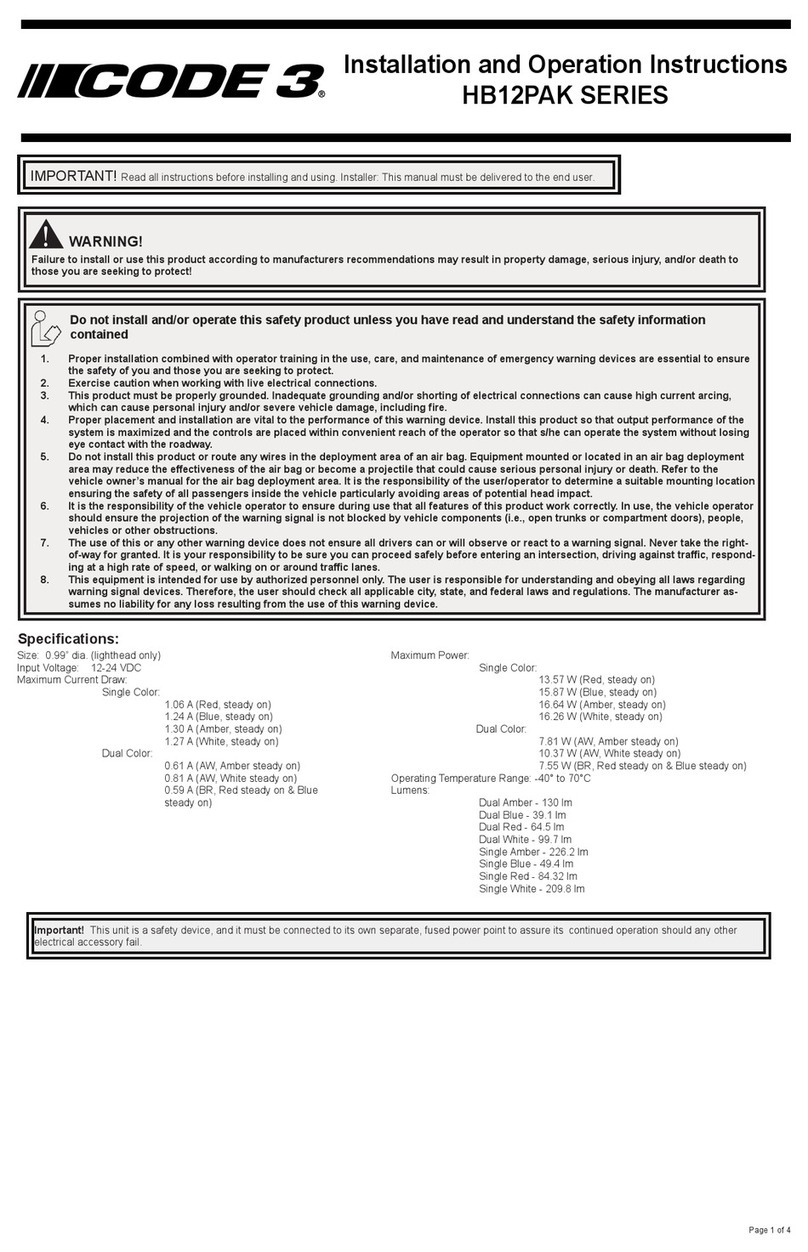
ECCO SAFETY GROUP
ECCO SAFETY GROUP Code 3 HB12PAK Series Installation and operation instructions
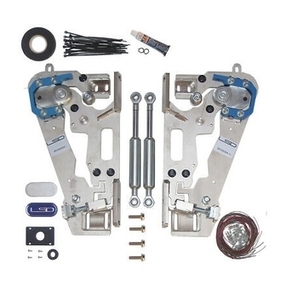
LSD-Doors
LSD-Doors LamboStyleDoors installation instructions
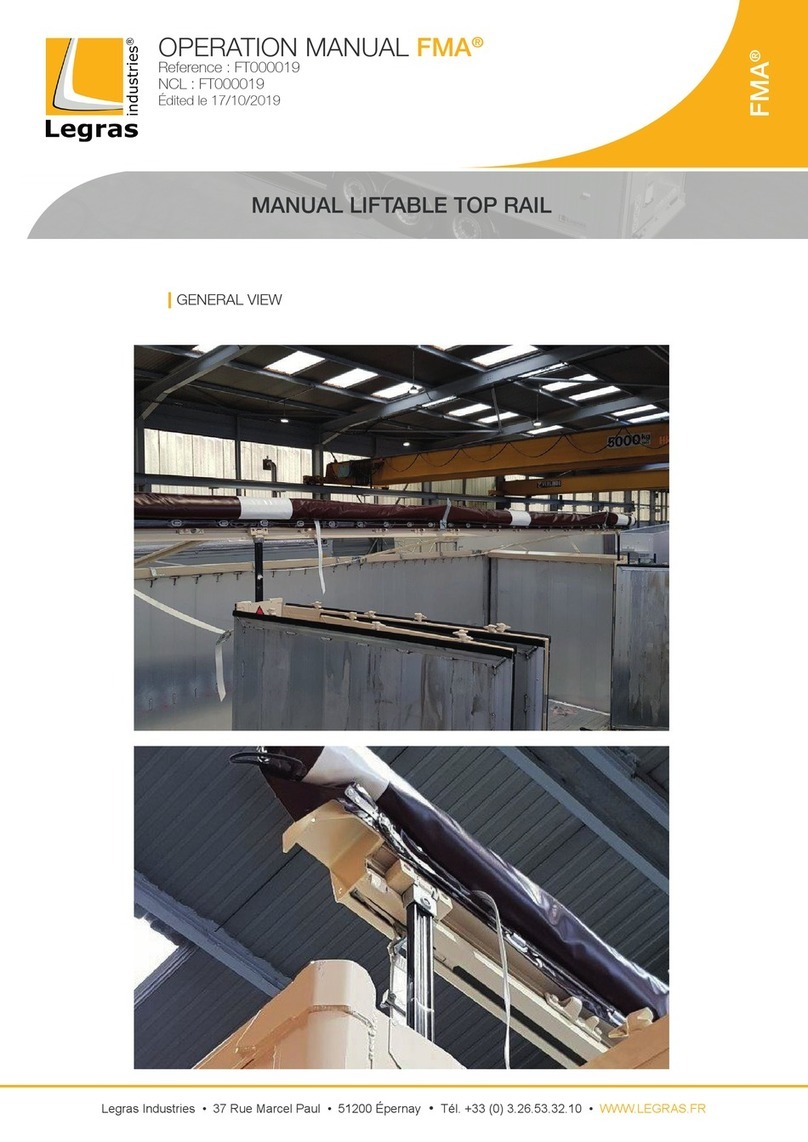
Legras
Legras FMA Operation manual

Front Runner
Front Runner Easy-Out Fitting instructions

Thule
Thule Cascade XT 676XT installation instructions
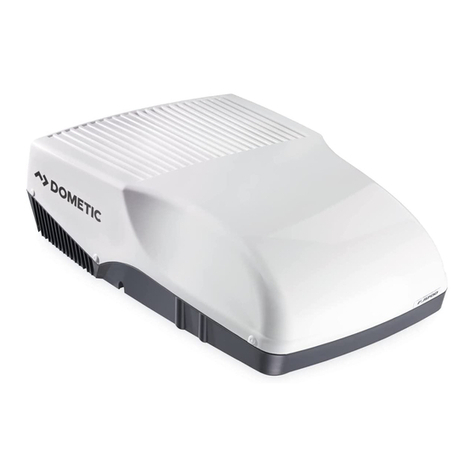
Dometic
Dometic FRESHJET FJ1100 operating manual
